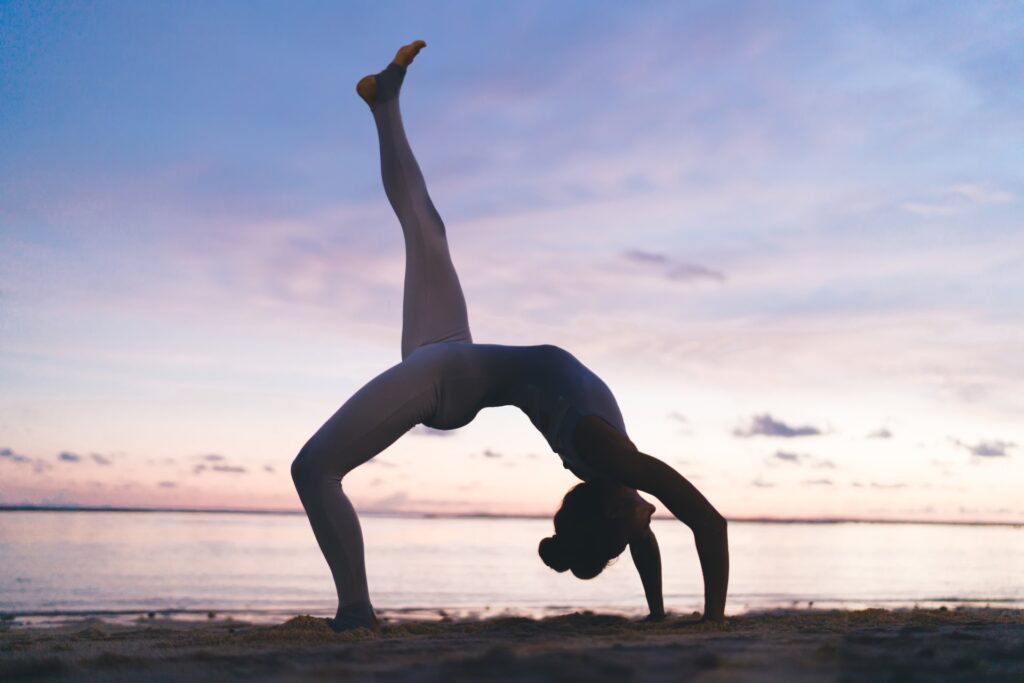“Elevate your yoga practice to new heights with the challenging and invigorating One-Legged Inverted Staff Pose (Eka Pada Viparita Dandasana), an advanced asana that combines strength, flexibility, and balance.”
One-Legged Inverted Staff Pose, known as Eka Pada Viparita Dandasana in Sanskrit, is an advanced yoga pose that takes your practice to the next level. This challenging asana demands a combination of strength, flexibility, and balance. By inverting your body and elevating one leg, you not only build physical prowess but also cultivate mental focus. In this article, we’ll explore the origin, benefits, and step-by-step instructions for mastering Eka Pada Viparita Dandasana.
Origin and Symbolism
The name “Eka Pada Viparita Dandasana” can be broken down into Sanskrit terms: “Eka” meaning “one,” “Pada” meaning “foot,” “Viparita” meaning “inverted,” and “Danda” meaning “staff” or “stick.” This pose represents the inversion of the body while maintaining a staff-like straightness in the arms and torso. Symbolically, it embodies the balance of opposites, strength within flexibility, and focus amid challenge.
Benefits
One-Legged Inverted Staff Pose (Eka Pada Viparita Dandasana) offers a wide range of physical and mental benefits:
- Strengthens the Core: This pose engages the core muscles, promoting core strength and stability.
- Expands Chest and Lungs: The chest opening aspect of the pose enhances lung capacity and improves posture.
- Hip Flexor Stretch: Eka Pada Viparita Dandasana provides a deep stretch to the hip flexors, enhancing hip flexibility.
- Balance and Focus: The inversion and one-legged balance challenge mental focus and concentration.
- Boosts Confidence: Mastering this advanced pose can boost self-confidence and a sense of accomplishment.
Step-by-Step Instructions

- Preparation: Begin in Dandasana (Staff Pose) with your legs extended straight in front of you.
- Arm Placement: Place your hands on the floor several inches behind your hips, fingers pointing toward your feet.
- Shoulder Position: Press your palms firmly into the ground and lift your chest. Roll your shoulders back and broaden your collarbones.
- Bend Your Knees: Bend your knees and plant your feet firmly on the floor, heels close to your sit bones.
- Lift Your Hips: On an exhalation, press into your hands and feet to lift your hips off the floor. Your body forms a reverse tabletop position.
- One-Legged Lift: Inhale deeply as you extend one leg straight up toward the ceiling. Keep the other foot rooted.
- Strong Core: Engage your core muscles to maintain stability. Your body should resemble an inverted “L” shape.
- Hip Flexor Stretch: Feel the stretch in your lifted leg’s hip flexors and quad.
- Hold and Breathe: Hold the pose for 5-10 breaths, maintaining steady breathing. Gaze toward your extended foot.
- Release: Exhale as you slowly lower your lifted leg back down to the floor.
- Switch Sides: Repeat the same sequence on the opposite side, extending the other leg upward.
Variations and Modifications
If reaching a full one-legged lift is challenging, you can practice by lifting your foot only a few inches off the floor.
Tips for a Deeper Practice
Prioritize the engagement of your core muscles to stabilize your body. Focus on breathing deeply and evenly throughout the pose to maintain balance and concentration.
Preparation Poses
- Bridge Pose (Setu Bandha Sarvangasana): Start with Bridge Pose to open the chest, shoulders, and prepare the back for the deep backbend of Eka Pada Viparita Dandasana. Lie on your back, bend your knees, and lift your hips while keeping your feet and shoulders on the ground.
- Wheel Pose (Urdhva Dhanurasana): Wheel Pose is a more advanced backbend that can help you build the strength and flexibility needed for Eka Pada Viparita Dandasana. Begin by lying on your back with your feet flat on the ground near your hips and your hands placed by your shoulders. Push up into a full backbend, lifting your chest and pelvis off the floor.
- Bow Pose (Dhanurasana): Bow Pose is another preparatory pose that strengthens the back and opens the chest. Lie on your stomach, bend your knees, and reach back to hold your ankles. Lift your chest and legs off the ground as you arch your back.
Counter Poses
- Child’s Pose (Balasana): After practicing Eka Pada Viparita Dandasana, return to Child’s Pose to release any tension in your back and relax your spine. Kneel on the floor, sit back on your heels, and extend your arms forward while lowering your chest toward the ground.
- Bridge Pose (Setu Bandha Sarvangasana): Revisit Bridge Pose as a counter pose to release any residual tension in the back and gently stretch the spine.
- Corpse Pose (Savasana): Finish your practice with Corpse Pose to relax your entire body and allow it to absorb the benefits of the asana practice. Lie flat on your back with your arms by your sides, palms facing up, and completely relax.
Incorporating these preparation and counter poses into your advanced One-Legged Inverted Staff Pose (Eka Pada Viparita Dandasana) practice enhances the overall experience and ensures a balanced yoga session. Always practice mindfully and respect your body’s capabilities and limitations for a safe and enjoyable experience.
Final Thoughts

One-Legged Inverted Staff Pose (Eka Pada Viparita Dandasana) is a powerful and advanced yoga pose that challenges both body and mind. As you elevate one leg while inverting your body, you cultivate strength, flexibility, balance, and mental focus. While mastering this pose may take time and practice, the rewards in terms of physical prowess and inner fortitude are well worth the effort. Embrace the challenge and elevate your yoga practice with this invigorating asana.


